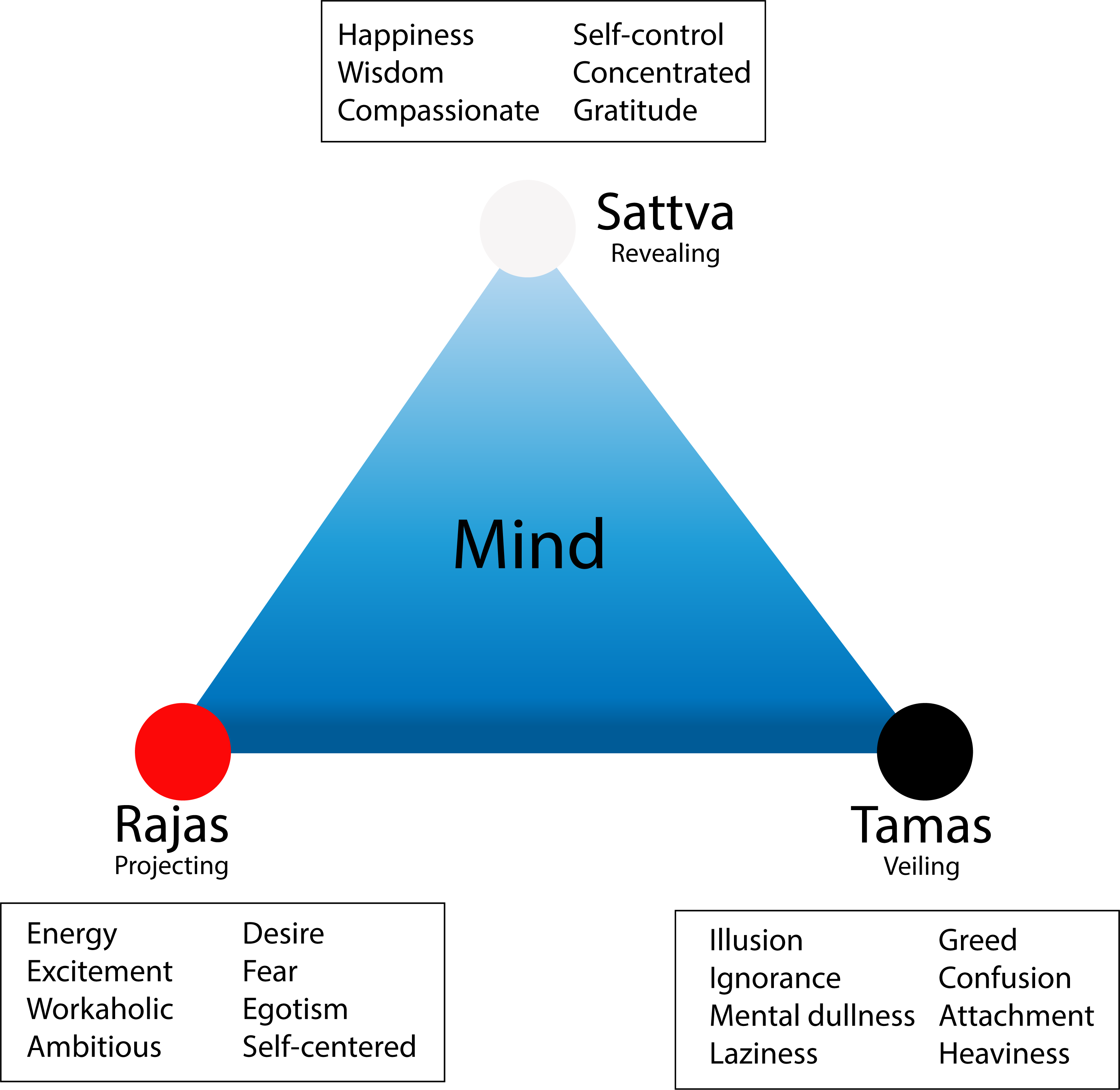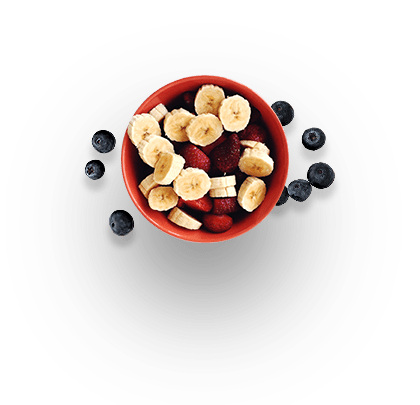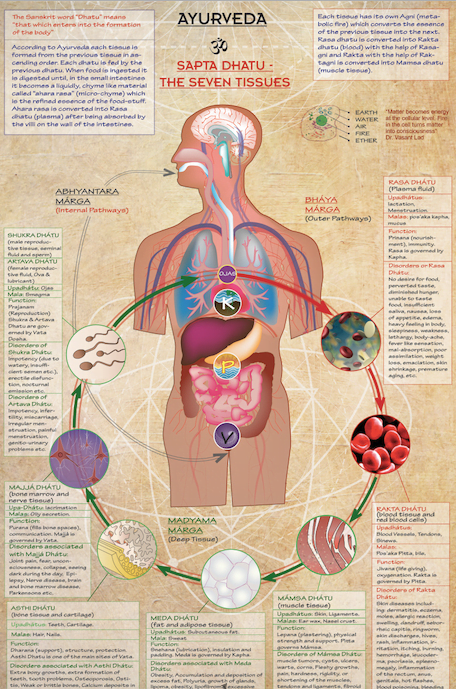
That Which Holds Together – Dharanat Dhatavah
The Universe is made up of energy and matter. The doshas represent energy and the dhātus represent matter. Dhātus are made up of mahābhūtas which are created from tanmātras. Tanmātras are the different vibrations of universal, cosmic energy. The doshas and dhātus are close friends, who cannot live or function without each other. The doshas work through the dhātus.
The 7 Dhatus
1. Rasa – Plasma, Serum, or Lymph with the nutritive essence
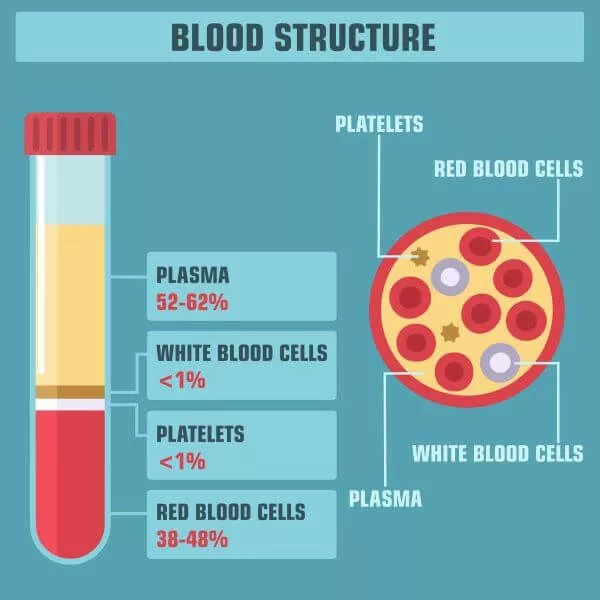
Location: Plasma, Lymph, Serum
Function: Prīṇana (Nourishment)
Upadhātu: Stanya (Breast milk), Raja (Menstrual fluid)
Time: Rasa takes 1 day to form after food ingestion.
Size: It measures 9 añjalis.
Composition: Made up of all mahābhūtas, but primarily Ap (jala, water)
Sites: Pervades in the whole body but main sites are heart, lymph channels, and venous blood.
Description: Rasa is the grossest of all the dhātus. It includes plasma, serum, lymph. Rasa is a juice or liquid (the juice of life) with nutrients for all the other dhātus. It provides a sense of satisfaction and nourishment to rakta dhātu.
Mala: Kapha
Functions
- Prīṇana: Nourishes all dhātus. Due to the process of catabolism, dhātus break down and become deficient. Rasa dhātu replenishes those, to maintain balance.
- Āhāra Rasa (Digested Food) is absorbed by blood vessels and carried to the liver. The liver contains Pañca mahābhūtāgnis, which further digest āhāra rasa. Dhātu agnis do further digestion to develop particular dhātus. First, rasa is created, which has all bhūtas for other dhātus. Thus, it provides nourishment to others.
- The intelligence and the subtle energy of Rasa, which comes from food, gives contentment to other dhātus. This energy maintains strength, love, and compassion
- It maintains body temperature and pH through sweat glands. Coagulates blood due to kapha.
- Responsible for lactation and menstruation.
Signs of Rasasāra or Optimum Rasa
- A person is happy, strong, healthy, and has a good memory
- Skin is soft, smooth, and glowing
- The hair (on the body and head) is oily, soft, and silky
2. Rakta – The blood tissue
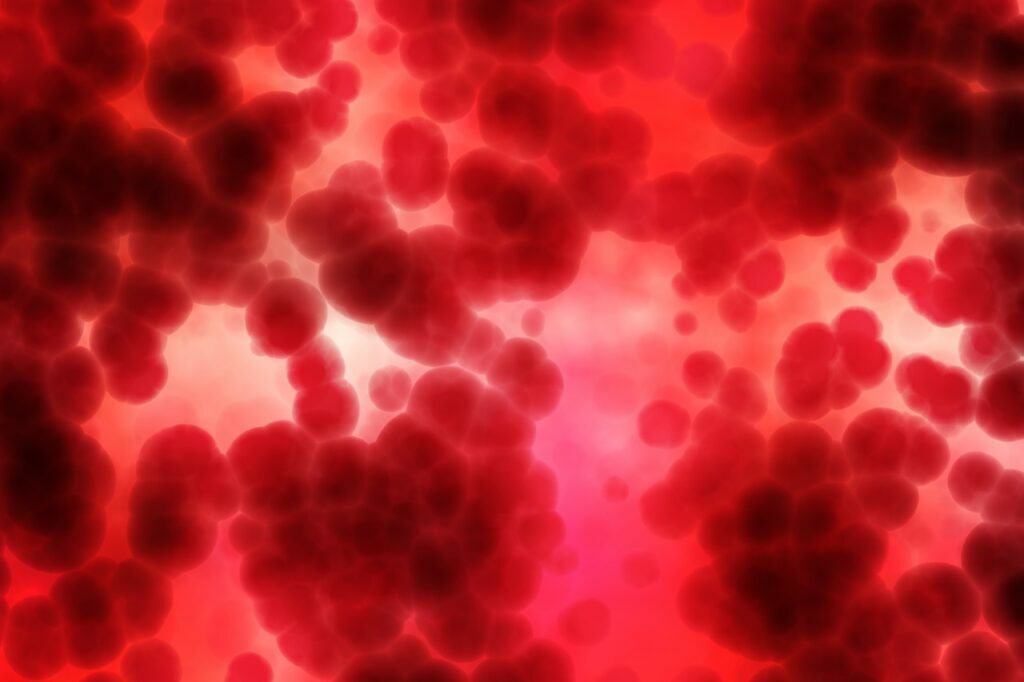
Location: Blood
Function: Jīvana (Giving life)
Upadhātu: Kaṇḍarā (Tendons), Sirā (Blood vessels)
Time: Rakta dhātu requires 6 days to form after food ingestion.
Size: It measures 8 añjalis.
Composition: All the mahābhūtas but mainly tejas (fire) and ap (water).
Sites: Bone marrow (red marrow), liver, spleen, red blood cells, heart, and uterus.
Description: Rakta dhātu represents the red blood cells in the body. It is named due to its color. Rakta means red.
Mala: Pitta
Functions
- Jīvana: Gives life by carrying prāṇa.
- Provides strength, energy, luster, happiness.
- Carries prāṇa to all the cells.
- Nourishes subtle dhātus.
- Provides enthusiasm, compassion, creativity, and ambition.
- Emotionally connected to anger, irritability, and jealousy (because related to pitta).
Signs of Raktasāra
- A person is bright, brilliant, and happy.
- There is vitality and strength.
- Skin is reddish and lustrous, and the eyes are bright.
- Pink lips, nails, conjunctiva.
- The body always feels warm and desires cooler things.
3. Māṃsa – The Muscle Tissue
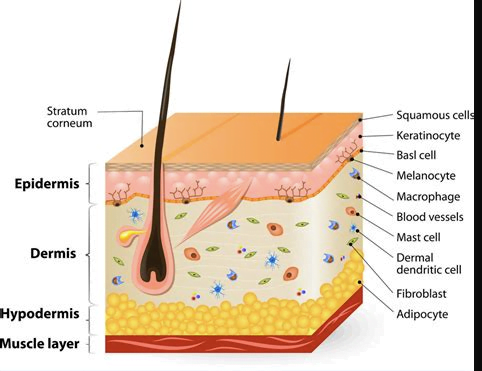
Location: Muscle
Function: Lepana (Plastering of the body)
Upadhātu: Vasā (Subcutaneous fat) , Tvak (Skin)
Time: It takes 11 days to form after food ingestion.
Size: It measures 8 añjalis.
Composition: Mainly pṛthvī (earth), tejas (fire), and ap (water).
Sites: Muscle tissue, organs of the body; Over the bones.
Description: Māṃsa dhātu represents the muscles in the body. The quantity of Māṃsa dhātu is variable depending on the individual, their prakṛti, and their habits.
Mala: Ear wax, nasal crust, smegma, and navel discharge
Functions
- Lepana: Plastering of the body.
- Many organs are made of Māṃsa dhātu.
- Regulates activities, moving joints, and bones, coordination, power.
- Gives strength to our body frame.
- Keeps skin smooth.
- Gives confidence, courage, and strength.
- Emotions are stored in fascia and connective tissue.
- Nourishes meda dhātu.
Signs of Māṃsasāra
- Muscular body, with a great tone.
- Excellent strength and stamina.
- Strong joints and coordination.
- A person looks strong, healthy, confident, rich, and intelligent.
4. Meda Dhātu – The Adipose Tissue
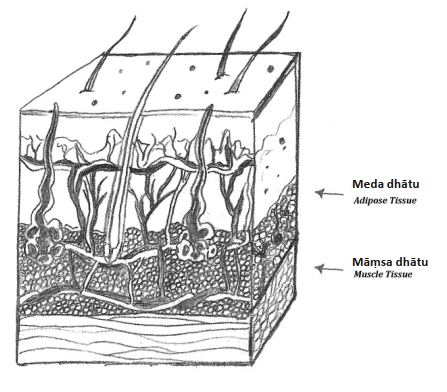
Location: Fat
Function: Snehana (Lubrication)
Upadhātu: Snāyu (Ligaments)
Time: It takes 16 days to form after food ingestion.
Size: It generally measures 2 añjalis, depending on the individual.
Composition: Ap (water), pṛthvī (earth), and tejas (fire).
Sites: All over the body, under skin, belly, omentum (a fold of peritoneum connecting or supporting the abdominal structures as the stomach and liver), buttocks, breasts, around joints, around heart, kidney.
Description: Represents the fat, lipids, adipose tissue, and cholesterol in the body. Its main location is in the omentum and kidneys.
Mala: Sveda (Sweat)
Functions
- Snehana: Keeps muscles lubricated for constant contraction and retraction; lubrication of joints.
- Keeps body strong, and supple; soft voice; oily and lustrous hair.
- Nourishes asthi dhātu.
- Retains heat.
Signs of Medasāra
- Well-built body, melodious voice.
- Skin, hair, eyes, nails, lips, and teeth are smooth, oily, and lustrous.
- Rounded and strong joints.
- A person is loving, forgiving, and compassionate.
5. Asthi Dhātu – The Bone Tissue
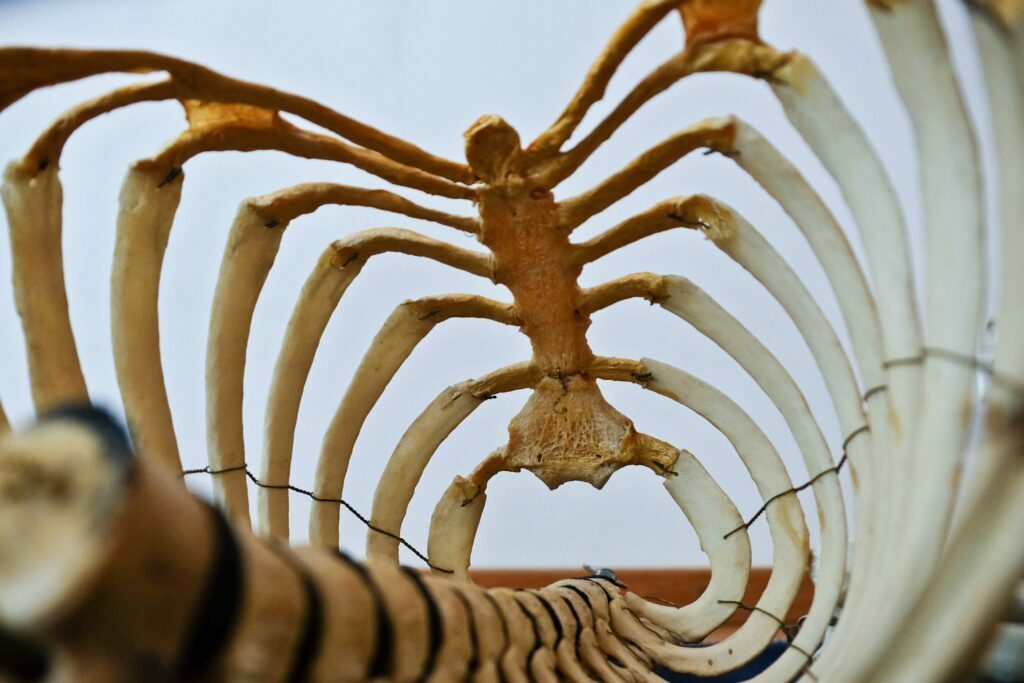
Location: Bone
Function: Dhāraṇa (Supporting the organs)
Upadhātu: Teeth, cartilage
Time: It takes 21 days to form after food ingestion.
Size: It generally measures 2 añjalis, depending on the individual.
Composition: Mainly pṛthvī (earth), ākāśa (space), and vāyu (air).
Sites: All the bones in the body.
Description: Asthi dhātu is the hardest dhātu in the body. Sthā means to stand or endure. Asthi dhātu is one of the seats of vāta. The junction of the bones is a sandhi or joint, which is filled and lubricated by śleṣaka kapha to prevent friction during movement.
Mala: Hair, Nails
Functions
- Dhāraṇa (To support): It supports the other dhātus in the body.
- Provides the skeleton to the body and gives shape, and stability to the body.
- Provides attachment to muscles.
- Protects vital organs (brain, spinal cord, pelvic organs) within.
- Assists in self-defense and protects the body.
- Carries sound (bones in the ears).
- Retains memory of pain, pleasure, sadness, and happiness, subconscious emotions.
- Many bone disorders are caused by old age.
- It nourishes majjā dhātu.
Signs of Asthisāra
- Long and strong bones, big and strong joints.
- Strong nails, hair, teeth.
- Is hardworking, energetic, and has great strength and stamina.
6. Majjā Dhātu – The Bone Marrow
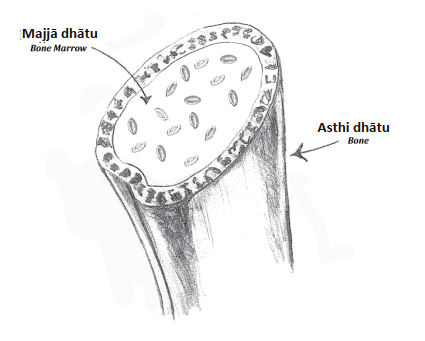
Location: Bone
Function: Dhāraṇa (Supporting the organs)
Upadhātu: Lacrimal secretions or tears.
Time: The nourishment of Majjā begins 26 days after food ingestion.
Size: It measures 1 añjali and represents ½ añjali of the brain tissue.
Composition: Mainly vāyu (air), ap (water), and pṛthvī (earth).
Sites: Within the bones, nerve tissue, and endocrine glands.
Description: Majjā dhātu represents the Bone Marrow in the body, as well as anything within the bone, the brain, spinal cord, red bone marrow, or nerve tissue of the body.
Mala: The oily secretions in the eyes, skin, and feces.
Functions
- Pūraṇa: Filling and strengthening the bones.
- Strengthening the body.
- Nourish śukra dhātu.
- Communication, sensory and motor function.
- Majjā is related to feelings, thoughts, and emotions in the past, present, and future.
Signs of Majjāsāra
- The body is strong but supple.
- Skin and voice are soft.
- Joints are strong and well-built.
- Eyes are big and lustrous.
- A person is strong, intelligent, respectable, and lives longer.
7. Śukra/Ārtava Dhātu – The Reproductive Tissue
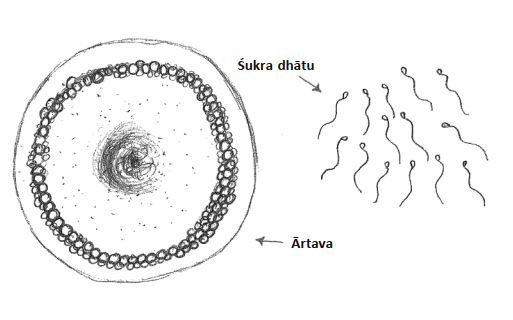
Location: Reproductive Fluid (Sperm or Ovum)
Function: Prajotpādana (Procreation)
Upadhātu: n/a
Time: It takes 31 days to form.
Size: It measures ½ añjali.
Composition: Mainly ap (water).
Sites: Male/female reproductive system.
Description: In males, Śukra dhātu represents the sperm; in females, ārtava dhātu represents the ovum in the body -or the female seed potential. It is the most subtle dhātu in the body. Śukra is cool, white, oily, sweet, liquid, and heavy. Ārtava is hot, astringent, sour, and acidic in smell.
Mala: n/a
Functions
- Prajotpādana: Reproduction and procreation.
- Provide vigor and vitality.
- Is the seed potential of all dhātus.
Signs of Śukrasāra
- Strength, stamina, vitality.
- Strong bones, eyes, nails, and hair.
- Enjoys physical intimacy with a partner.
- Many children.
Why is Śukra Dhātu so Important?
- Śukra is not merely located in the reproductive system. It is located all over the body.
- It increases the immune system, vigor, and vitality.
- In spirituality, controlling all the desires (especially sexual) is very important. The goal is to facilitate the life energy to move upwards.
- Mental calmness and clarity are increased by śukra.
- Śukra keeps the body very strong and free from disorder, and the intellect very sharp.


